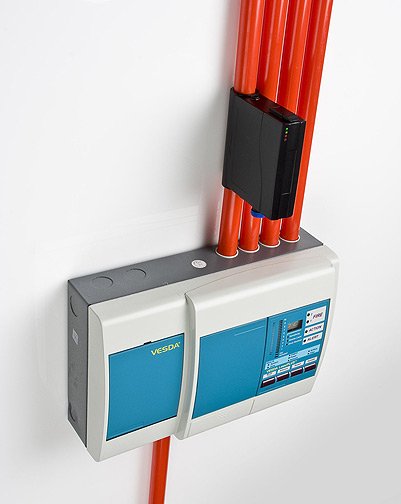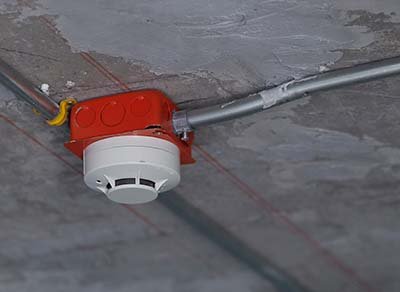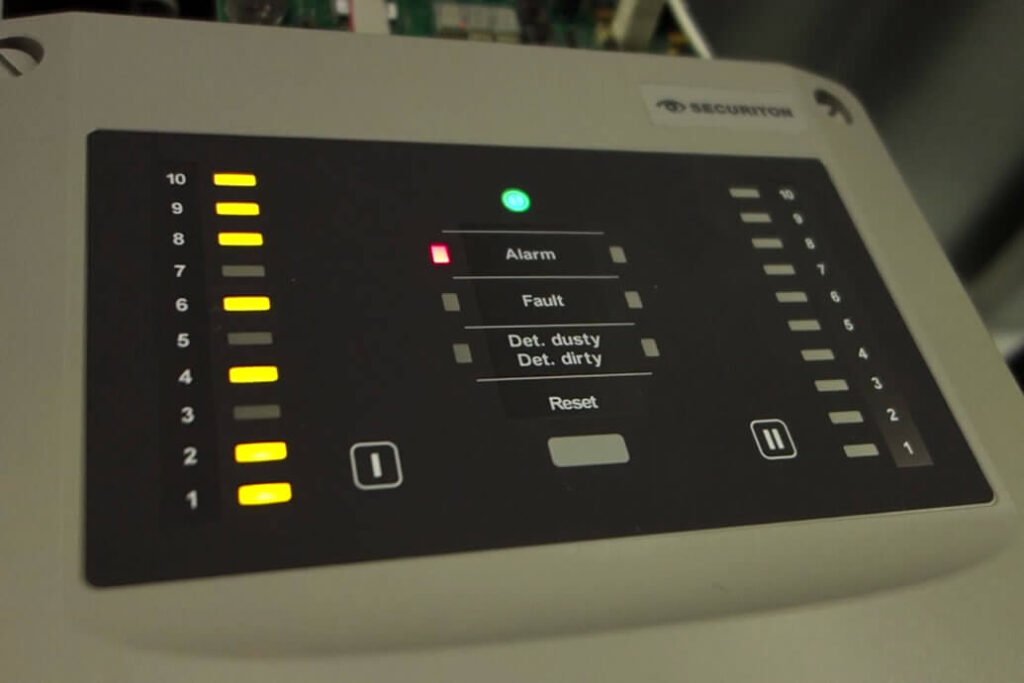Fire Alarm Systems: Ensuring Early Detection
In today’s fast-paced world, it’s crucial to invest in a reliable fire alarm system that ensures early detection of fires, giving you peace of mind and safeguarding your loved ones and belongings. With a wide array of brands to choose from, including Ring, Nest, Arlo, Wyze, SimpliSafe, Eufy Security, Blink, August Home, Honeywell Home, Ring Alarm, Vivint, Abode, Swann, Reolink, TP-Link Kasa, Logitech Circle, ADT, Schlage, First Alert, and Kangaroo, finding the perfect fire alarm system has never been easier. Whether you prefer a wireless system that seamlessly integrates with your smart devices or a tried-and-true traditional solution, these brands offer a variety of features to suit your needs. Don’t wait until it’s too late, make fire prevention a top priority with an effective fire alarm system today.
1. Basics of Fire Alarm Systems
1.1 What are Fire Alarm Systems?
Fire alarm systems are essential safety systems designed to detect and alert individuals about the presence of a fire or smoke in a building. These systems play a critical role in providing early detection, allowing for the safe evacuation of occupants and minimizing potential damage to property.
1.2 Importance of Early Detection
Early detection of fires is crucial in preventing or minimizing the devastating effects that can occur. Fire alarm systems serve as the first line of defense, providing a timely warning to occupants and enabling them to take necessary actions to protect themselves and escape safely. By detecting the presence of smoke or fire at its early stages, these systems greatly reduce the risks associated with fire emergencies.
2. Types of Fire Alarm Systems
2.1 Conventional Fire Alarm Systems
Conventional fire alarm systems are a common choice for smaller buildings or those with simpler configurations. These systems divide the building into zones, with each zone connected to a specific detector or manual call point. When a detector or call point is triggered, the system identifies the respective zone, allowing for easier location of the fire or smoke source.
2.2 Addressable Fire Alarm Systems
Addressable fire alarm systems offer more advanced capabilities and are suitable for larger buildings or those with complex layouts. In this type of system, each detector or device has a unique address, enabling the control panel to identify the specific location of the activated device. Addressable systems provide detailed information about the fire location, making it easier for emergency responders to take immediate action.
2.3 Analog Fire Alarm Systems
Analog fire alarm systems utilize advanced technology to continuously sample environmental data, providing a more accurate detection of fire or smoke. These systems monitor changes in the environment and assess them against preset thresholds, ensuring a higher level of reliability in detecting fires. Analog systems can also provide important information about the severity of the fire, allowing for appropriate response measures.
2.4 Wireless Fire Alarm Systems
Wireless fire alarm systems offer the advantage of flexibility and ease of installation. These systems use wireless communication technology to connect detectors, control panels, and other devices without the need for extensive wiring. Wireless systems are particularly beneficial for retrofitting existing buildings or areas where wiring installations may be challenging.
2.5 Smart Fire Alarm Systems
Smart fire alarm systems integrate advanced technologies, such as internet connectivity and artificial intelligence, to provide enhanced capabilities. These systems offer features like remote monitoring, real-time alerts, and integration with other smart devices. Smart fire alarms can send notifications to smartphones or personal devices, allowing users to receive updates and take immediate action, even when they are away from the premises.

3. Components of Fire Alarm Systems
3.1 Smoke and Heat Detectors
Smoke and heat detectors are the primary devices used to detect the presence of a fire. Smoke detectors respond to the particles or combustion gases produced during a fire, while heat detectors measure the temperature rise beyond a certain threshold. These detectors are strategically placed throughout a building to ensure early detection.
3.2 Control Panel
The control panel serves as the central command center of the fire alarm system. It receives signals from detectors and other devices and provides audible and visual notifications in case of an emergency. The control panel also facilitates communication with monitoring stations and can activate other safety measures, such as fire suppression systems.
3.3 Notification Devices
Notification devices are responsible for alerting occupants about a fire emergency. These devices can include audible alarms, strobe lights, or voice evacuation systems. The selection of appropriate notification devices depends on factors such as the size of the building, the environment, and the needs of the occupants.
3.4 Monitoring Stations
Monitoring stations play a crucial role in ensuring the timely response to fire emergencies. These stations receive signals from fire alarm systems and can alert the necessary authorities, such as the fire department or emergency services. Monitoring stations provide an additional layer of protection by ensuring that help is on the way when an alarm is triggered, even if occupants are unable to call for help themselves.
3.5 Backup Power Supply
A reliable backup power supply is essential to ensure the continuous operation of a fire alarm system, particularly during power outages. Backup batteries or generators help maintain the functionality of the system, ensuring that it remains operational when most needed.
4. Choosing the Right Fire Alarm System
4.1 Assessing Building and Fire Risks
When selecting a fire alarm system, it is crucial to assess the specific risks associated with the building and its occupants. Factors such as occupancy type, building layout, presence of hazardous materials, and local fire history should be considered to determine the appropriate level of detection and alarm capabilities required.
4.2 Understanding Local Regulations
It is important to be familiar with local fire codes and regulations when choosing a fire alarm system. Different jurisdictions may have specific requirements that must be met to ensure compliance. Consulting with local authorities or fire safety professionals can provide valuable guidance in navigating these regulations.
4.3 Budget Considerations
Budgetary constraints are a key factor in choosing a fire alarm system. It is important to strike a balance between affordability and the level of protection required. While it may be tempting to opt for a cheaper option, compromising on the quality and reliability of the system can have severe consequences in the event of a fire emergency.
4.4 Compatibility with Other Security Systems
Consideration should also be given to the compatibility of the fire alarm system with other security systems present in the building. Integration with access control systems, CCTV cameras, or building automation systems can provide a comprehensive approach to safety and security.

5. Popular Fire Alarm System Brands
Choosing the right fire alarm system brand is crucial for ensuring reliability and performance. Here are some well-known brands in the market:
5.1 Ring
Ring offers a range of smart fire alarm systems that can be seamlessly integrated into its wider home security ecosystem. With features like smartphone notifications and easy installation, Ring provides a user-friendly experience for homeowners.
5.2 Nest
Nest, known for its innovative home automation products, also offers fire alarm systems. Nest’s devices are designed to work together, allowing for easy integration with other Nest products and smartphone control.
5.3 Arlo
Arlo specializes in wireless security systems and also provides fire alarm solutions. Arlo’s fire alarms offer wireless connectivity, enabling quick and convenient installation without the need for extensive wiring.
5.4 Wyze
Wyze offers affordable and feature-rich fire alarm systems that cater to the needs of homeowners on a budget. Wyze’s devices are known for their reliability and simplicity, making them a popular choice for residential settings.
5.5 SimpliSafe
SimpliSafe is a renowned brand in home security, including fire alarm systems. Their wireless and customizable solutions provide peace of mind to homeowners with their easy installation and professional monitoring options.
5.6 Eufy Security
Eufy Security offers a range of fire alarm systems that integrate seamlessly with their wider smart home ecosystem. With advanced features like remote monitoring and voice control compatibility, Eufy Security provides a comprehensive approach to home safety.
5.7 Blink
Blink offers affordable and user-friendly fire alarm systems that are easy to install and operate. Their wireless connectivity and battery-powered devices make them suitable for various residential settings.
5.8 August Home
August Home’s fire alarm systems combine traditional functionality with smart technology. With features like smartphone alerts and remote control, August Home provides convenience and peace of mind to homeowners.
5.9 Honeywell Home
Honeywell Home is a trusted name in the fire alarm industry, offering a wide range of reliable and technologically advanced solutions. Their fire alarms provide accurate detection and timely alerts, ensuring the safety of occupants.
5.10 Ring Alarm
Ring Alarm, a subsidiary of Ring, specializes in comprehensive home security systems, including fire alarms. Ring Alarm’s fire alarms offer easy installation, smartphone integration, and professional monitoring options.
5.11 Vivint
Vivint offers professionally installed fire alarm systems that are seamlessly integrated with their wider smart home ecosystem. With 24/7 professional monitoring and advanced detection technology, Vivint ensures a high level of safety and security.
5.12 Abode
Abode provides customizable fire alarm systems that can be easily integrated into their wider home security ecosystem. Their devices offer features like smartphone alerts, easy installation, and compatibility with other smart devices.
5.13 Swann
Swann offers a range of fire alarm systems designed for both residential and commercial settings. With features like remote monitoring and compatibility with Swann’s broader security solutions, their fire alarms provide comprehensive protection.
5.14 Reolink
Reolink specializes in wireless security systems and also offers fire alarm solutions. Reolink’s fire alarms provide reliable and accurate detection, ensuring early warning and timely response.
5.15 TP-Link Kasa
TP-Link Kasa offers fire alarm systems that seamlessly integrate with their wider smart home ecosystem. Their devices provide advanced features like smartphone control and voice activation, enhancing convenience and ease of use.
5.16 Logitech Circle
Logitech Circle offers fire alarm systems that combine smart technology with ease of use. With features like smartphone alerts and compatibility with other Circle devices, Logitech Circle ensures a comprehensive and user-friendly experience.
5.17 ADT
ADT is a well-known provider of fire alarm systems and overall security solutions. With a long history of excellence, ADT offers a range of fire alarms that can be tailored to meet the unique needs of different environments.
5.18 Schlage
Schlage, a trusted brand in security, also offers fire alarm systems designed for both residential and commercial settings. Their systems provide reliable detection and easy integration with other security devices.
5.19 First Alert
First Alert is a renowned brand specializing in fire safety solutions. Their fire alarm systems offer reliable detection capabilities and come with additional features like carbon monoxide detection and advanced notification options.
5.20 Kangaroo
Kangaroo provides affordable and user-friendly fire alarm systems that are suitable for residential settings. With features like smartphone alerts and easy installation, Kangaroo ensures simplicity and convenience for homeowners.
6. Installation and Maintenance of Fire Alarm Systems
6.1 Professional Installation vs. DIY
The installation of a fire alarm system can be done professionally or as a do-it-yourself (DIY) project. For complex systems or larger buildings, professional installation is often recommended to ensure proper setup and compliance with local regulations. DIY installation may be suitable for smaller, simpler systems or for homeowners with appropriate knowledge and skills.
6.2 Regular Testing and Inspection
Regular testing and inspection are crucial to ensure the ongoing functionality of a fire alarm system. This includes testing alarms, detectors, and notification devices to ensure they are in proper working condition. Additionally, periodic inspections by qualified professionals help identify any maintenance or repair needs and ensure compliance with regulations.
6.3 Common Maintenance Tasks
Routine maintenance tasks for fire alarm systems include cleaning detectors and notification devices, replacing batteries, and checking the condition of wiring and control panels. It is important to follow the manufacturer’s guidelines and consult with professionals to ensure proper maintenance procedures are followed.

7. Integration with Home Automation Systems
7.1 Benefits of Integrating Fire Alarm Systems
Integrating fire alarm systems with home automation systems offers several benefits. It allows for centralized control and monitoring of various security devices, making it easier to manage and respond to emergencies. Integration with home automation systems also enables the automation of specific actions, such as automatically unlocking doors or turning on lights when a fire alarm is triggered.
7.2 Compatible Automation Devices
Fire alarm systems can be integrated with a wide range of automation devices, including smart door locks, surveillance cameras, and lighting systems. Compatible devices can be programmed to respond in specific ways when a fire alarm is triggered, enhancing safety measures and facilitating a coordinated emergency response.
7.3 Controlling and Monitoring through Smart Devices
Integration with smart devices, such as smartphones or tablets, allows for remote control and monitoring of fire alarm systems. Users can receive real-time notifications and access the status of the system from anywhere, enabling them to take immediate action or contact emergency services if needed.
8. Fire Alarm System Regulations and Codes
8.1 National Fire Protection Association (NFPA) Codes
The National Fire Protection Association (NFPA) establishes codes and standards for fire alarm systems to ensure the safety of buildings and occupants. These codes provide guidelines for the design, installation, and maintenance of fire alarm systems, covering various aspects such as detection, notification, and control.
8.2 International Building Code (IBC)
The International Building Code (IBC) sets forth regulations for building safety, including fire alarm systems, on an international scale. The IBC addresses fire prevention, evacuation procedures, and the requirements for fire alarm systems, ensuring consistency and uniformity across different jurisdictions.
8.3 Local Fire Department Regulations
In addition to national and international codes, local fire departments may have specific regulations that must be followed when installing or maintaining fire alarm systems. Local authorities have the expertise and insights into the unique fire risks in their jurisdictions, making compliance with their regulations essential for effective fire safety.

9. Fire Alarm Systems for Different Environments
9.1 Residential Fire Alarm Systems
Residential fire alarm systems are designed to protect homes and ensure the safety of occupants. These systems can range from basic smoke detectors to more advanced interconnected systems that provide alerts throughout the entire residence. Residential fire alarm systems are typically tailored to the specific needs and layout of the home.
9.2 Commercial Fire Alarm Systems
Commercial fire alarm systems are designed to protect businesses, offices, and other commercial buildings. These systems often include features like advanced detection technology, notification devices, and integration with other security systems. Commercial fire alarm systems are typically more complex due to the larger scale and specific requirements of commercial environments.
9.3 Industrial Fire Alarm Systems
Industrial fire alarm systems are specifically designed for the unique hazards and challenges present in industrial settings. These systems are tailored to the specific industry and may include specialized detectors for detecting hazardous gases, heat, or smoke. Industrial fire alarm systems are often integrated with other industrial safety measures, such as sprinkler systems or emergency shutdown procedures.
9.4 Specialized Environments
Certain environments require specialized fire alarm systems to address specific risks. This may include environments such as healthcare facilities, laboratories, data centers, or museums, which have unique fire hazards and protection requirements. Specialized fire alarm systems are designed to provide tailored solutions that consider the specific needs and challenges of these environments.
10. Advancements in Fire Alarm Technology
10.1 Artificial Intelligence and Machine Learning
Artificial intelligence (AI) and machine learning (ML) technologies are being increasingly integrated into fire alarm systems. These advancements enable systems to analyze data patterns, identify potential fire risks, and make more accurate predictions. AI and ML also enhance the system’s ability to minimize false alarms and provide early detection of fires.
10.2 IoT Connectivity
The Internet of Things (IoT) connectivity allows fire alarm systems to be remotely monitored and controlled through internet-enabled devices. This connectivity enables real-time data transmission to monitoring stations, alerts to personal devices, and seamless integration with other smart devices within a building’s automation ecosystem.
10.3 Wireless Mesh Networks
Wireless mesh networks are becoming more prevalent in fire alarm systems, particularly in complex or large-scale buildings. This technology allows for multiple interconnected devices to form a self-healing network, improving communication reliability and extending the wireless coverage range of the system.
10.4 Voice Activation and Voice Alerts
Voice activation and voice alerts are gaining popularity in fire alarm systems, providing an additional layer of communication during emergencies. These systems can provide spoken alerts and instructions to occupants, enhancing their understanding of the situation and facilitating a more organized and efficient evacuation.
In conclusion, fire alarm systems play a crucial role in ensuring early detection of fires and providing timely alerts for the safe evacuation of occupants. With various types of systems, components, and brands available, it is essential to choose the right fire alarm system based on building and fire risks, local regulations, budget considerations, and compatibility with other security systems. Regular maintenance and integration with home automation systems can further enhance the effectiveness and convenience of fire alarm systems. Compliance with fire alarm system regulations and codes, as well as consideration for different environments and advancements in technology, contribute to a comprehensive and reliable fire safety strategy.

